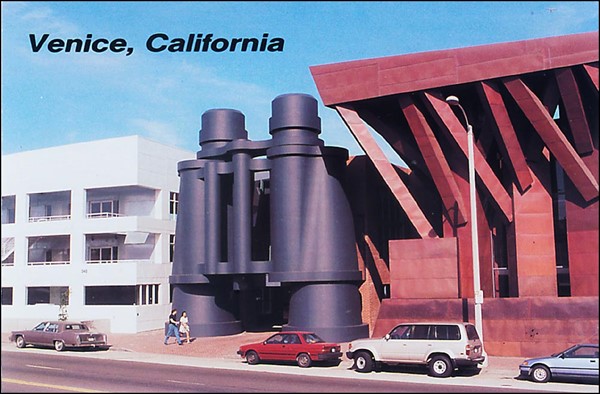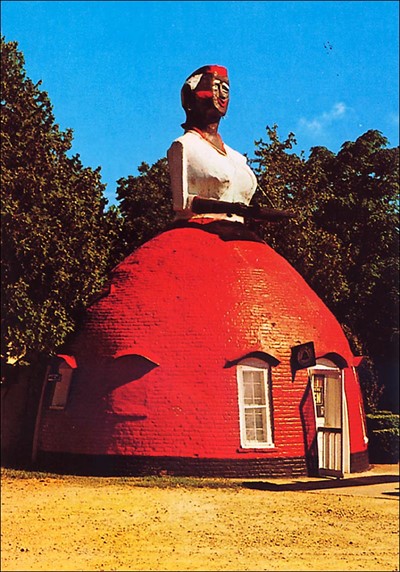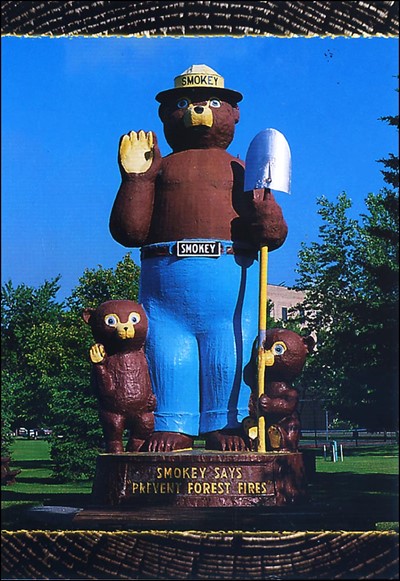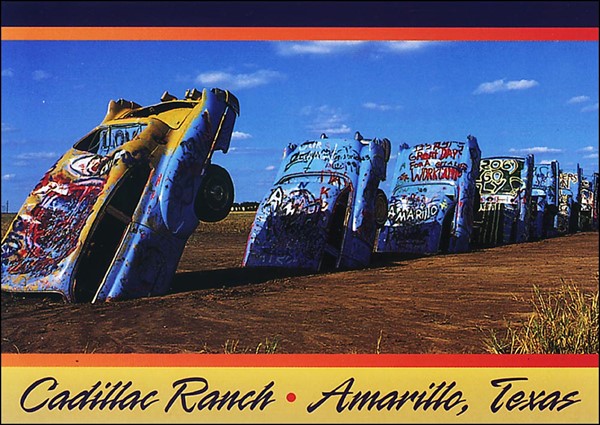Bonnie Wilpon
Roadside Attractions in America
One reason to travel in America is to see things we don’t see everywhere. Sometimes we drive long distances to visit relatives; sometimes for work, and when we’re lucky, we are on vacation to an enjoyable destination. Summer is the season when many Americans take to the road, so winter (in our new year) is a perfect time to reminisce over some roadside attraction postcards from the past.

“Roadside America” as a postcard collecting topic refers to places along the highways that in and of themselves are not tourist destinations. Some of the sub-categories are motels and service stations, but today the focus will be on buildings and giant objects that catch our attention as we pass by and otherwise have no need to stop. More specifically, we turn our attention to modern postcards that show these wondrous and sometimes hilarious objects.
During long, boring drives after we see countless trees, shopping centers and housing developments, we come across something so amazing, so eye-catching, and so unbelievable that we just have to stop, get out of the car and look. We might spend a few minutes staring and smiling; we might read a sign explaining what this crazy thing is; or we might even snap a photo. And we might just buy a postcard, to share with friends and loved ones. After all, how could anyone resist saying, “Wish you were here?” when we come across sights (and sites) like these:
Remember your high school history class; you learned that Albert Fall, Secretary of the Interior under President Warren G. Harding, went to prison for leasing Navy petroleum reserves at Teapot Dome, Wyoming, and two other locations to private oil companies at low rates without competitive bids. Before Watergate, this was America’s most notorious political scandal.
The Teapot Dome full-service gas station was built in 1922 by Jack Ainsworth. He hoped to remind his fellow citizens of the Teapot Dome Scandal. In July 2012, it was relocated to downtown Zillah, and is now a visitor center. Zillah is proud to say that the Teapot Dome Service Station is listed on the National Register of Historic Places.

The Binoculars Building is an office complex in Venice, California, just four blocks from the Pacific Ocean. Built in 1991, it was designed by Los Angeles architect Frank Gehry as the west coast corporate headquarters of the Chiat/Day advertising agency. Chiat/Day later moved out of the building and in 2011 Google leased part of it.
This three-story, 75,000-square-foot office space sits on top of three levels of underground parking. The car entrance to the garage (as well as a pedestrian entrance) is through the lenses of the binoculars. The middle of the binoculars forms a very long skylight, extending down from the third floor to the ground. The eyepieces at the top serve as skylights in two small conference rooms. It’s quite an ecological design; the columns are made of copper which creates a sunscreen.

This is a place you simply must see. Be prepared to make new friends; the place will be full of locals who know Mammy’s for the great food and quick service.
The original restaurant opened in 1940, it has often been remodeled, but the design remained the same.
You should know that Mammy’s attracted some unwanted attention during the 1960s Civil Rights Movement, the appeasement was to repaint Mammy’s with a lighter flesh-tone. Not surprisingly one guidebook to Mississippi suggests that if you want to visit the restaurant, “you need to check your political correctness at the door.”

Smokey the Bear was created by the National Forest Service in 1944, as a national symbol for fire prevention. His “job” was to keep careless campers from destroying America’s lumber supply. Generations of children can quote his one and only line… “Only YOU can prevent forest fires.”
International Falls, Minnesota, joined the campaign in 1953 when they built this fiberglass over a steel frame, example of Smokey as a project of the Koochiching County’s Keep Minnesota Green Committee. The sculptor was Gordon Shumaker. He captured Smokey’s noble sincerity with a raised right hand signaling “Stop”—a gesture copied by the cute cub on the left.
A live Smokey the bear was crowned in 1950. A black bear cub, who was burned in a New Mexico forest fire, was rescued and became the main attraction at the National Zoo in Washington, DC. He received so much fan mail he had his own Zip Code. In 1962, he was introduced to a lovely bear named Goldie, with the hope of a family of little Smokeys; but they never had cubs. Smokey died in 1976, and, in a stroke of irony, his body was cremated.

“Made ya’ look” is what comes to mind at Cadillac Ranch, along Route 66 in Amarillo, Texas. You can see this public art installation from Interstate 40 and can even get up close and personal by walking through the unlocked gate.
Local millionaire Stanley Marsh III is the patron of these heads-in-the-sand cars, one of several of his art projects. Created in 1974 by the art group Ant Farm, the grouping was made up of ten Cadillacs, model years 1949-63, facing west in a line, to illustrate the evolution of the iconic tail fin.
Over the years, visitors have been invited to add their own graffiti to the exhibit, which may be the only place where such a thing is encouraged. The graffiti has decorated the cars in wild and imaginative ways with ever-changing designs. Sometimes the cars are deliberately repainted—once pink to celebrate Stanley’s wife, Wendy’s, birthday; another time all ten Cadillacs were painted flat black to mark the passing of Ant Farm artist Doug Michels; in 2012 they were painted rainbow colors to commemorate Gay Pride Day.

The pride of Audubon, Iowa, Albert the Bull has been watching over the town with his baby blue eyes since 1964. The biggest bull in the world stands 30 feet tall and 33 feet long, with a 15-foot span between his horns. Albert weighs 45 tons, most of it concrete, and he can be seen from Highway 71 at the south edge of town.
Sponsored by the Audubon Jaycees, the $30,000 building expense was obtained through fund-raising activities and donations, with a big boost from the American Hereford Association. Abandoned windmills and other steel equipment were recycled and used as reinforcing material for the platform.
According to Albert, whose voice can be heard by pressing a button on the nearby kiosk, 20,000 people visit him every year, and he will tell you that, “I was even a question on Jeopardy!” Audubon’s official Albert the Bull Fact Sheet notes that the original idea was for Albert to promote the beef industry as a vital factor to the economy of Iowa and the nation. In addition, the huge critter would be a much-needed tourist attraction for the area. Albert has done his job well.

The world’s largest basket, on Main Street in Newark, Ohio, is also the seven-story, 180,000-square-foot corporate headquarters of the Longaberger Basket Company.
Company founder Dave Longaberger envisioned running his growing business from this replica of their market basket. One hundred and 60 times larger than the original hand-woven maple picnic packer, this unique building is 208 feet long and 142 feet wide. Employees moved into the building shortly before Christmas in 1997.
The idea for the family-owned business began with Dave’s father, J.W. Longaberger, who became an apprentice basket-maker in 1919. Since Dave’s death, the firm is owned by his daughters, Tami and Rachel. Longaberger sells baskets, pottery, home accessories and specialty foods through 45,000 independent consultants, through home parties and direct sales.
Each basket is signed and dated by the craftsperson who made it, and the company’s stamp is placed on the bottom. More than 500,000 tourists and fans, many of whom are members of the company’s collectors club, visit the basket each year.

The hollow sculpture is made of a series of wooden hoops covered with chicken wire, polyurethane, and aluminum foil, painted to resemble a peanut. The “mysterious” hole in the Peanut’s back was made by the Secret Service in 1976, to make sure the lighthearted legume didn’t hold a bomb or any other danger.
For years, the Peanut sat on the steps of the Plains train depot where tourists were never bashful about ripping pieces off it or painting it with graffiti. The owners, who were also proprietors of the Davis E. Z. Shop didn’t think that was right, so they rescued the Peanut, filled its bottom with concrete and set it in front of their store along Highway 45 about half-mile north of town.
The people of Plains keep the Peanut in good repair, and he’s even fully winterized.
Thank you for a good article that will sponsor a thousand looks at novelty cards.
So glad you enjoyed it! Happy hunting.
Every time I see and read an article like this one, I want to hit the road to see the sites in person! Thanks Bonnie, always learning from postcards.
Me too! I’ve gotten many of the postcards in my “Roadside” collection from the sites themselves.
Thanks! Hope this article gets you hunting for fun postcards!
Fascinating article! There are also Canadian version of these roadside attractions.
Good story, Bonnie. The Longaburger Basket Co. went out of the business some years ago, and the building was vacant when I saw it about a year ago, and at last report still is. It is stuck in redevelopment limbo, apparently.
Roadside cards are great. Some of the best in Americana to me. Thanks Bonnie